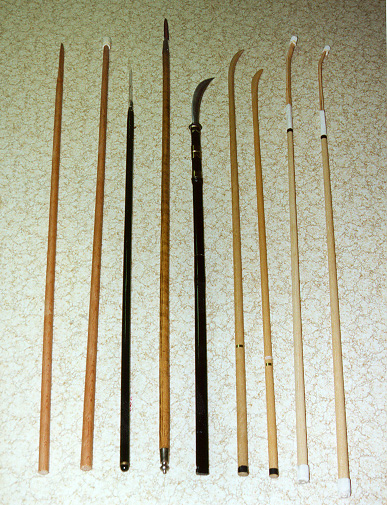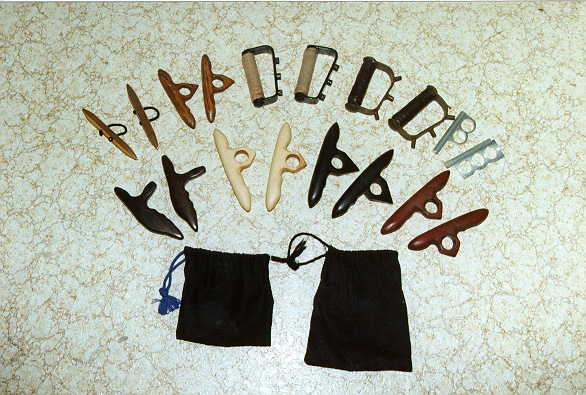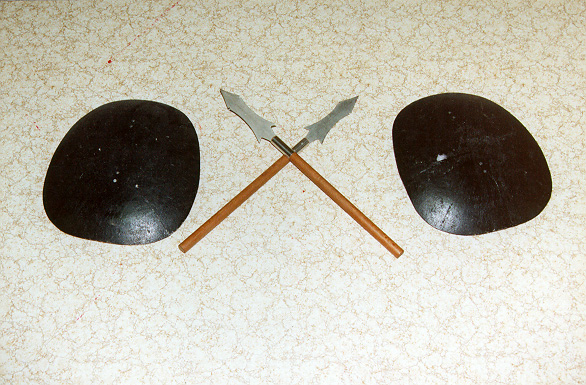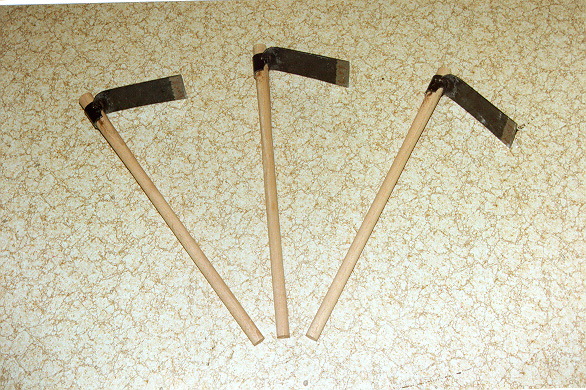Feature Article of the Quarter
OKINAWA KOBUDO'S LESSER KNOWN WEAPONS
By: C. Bruce Heilman (IKKF President)
Most martial artists have at lest a basic knowledge of the more well-known weapons of Okinawa. Surprisingly, however there is a vast array of weapons virtually unheard of in the West.
Today most people involved in the martial arts and even many of the general public have become aware of some of the martial arts weapons. Probably, the most widely known of the Okinawan weapons is the Nunchaku, which received its notoriety in numerous martial arts movies during the 1970's and 80's. Others may to a lesser extent be aware of the Bo, Tunfa and Sai. However, there exist a number of other significant weapons to traditional Okinawan Kobudo that the knowledge of which is limited to the most serious Karate/Kobudo practitioners.
The work "kobudo" means "ancient weapons way". In this article the author's focus will be on some of the lesser-known weapons of Okinawan Kobudo. Okinawan kobudo had its start around 400 years ago when Japan began to assert control over the Island of Okinawa. One of the edicts forced the Okinawan people to turn over their weapons to the Japanese. The move was made by Imperial Japanese leaders with almost no realistic political foresight and very little insight or perception into the Okinawan way of thinking. The ruling classes assumed that to gain political and financial control over this tenacious island race, all that was necessary was to disarm the people. The edict specifically ordered that "all weapons" be turned over to the authorities. Little did the authorities realize that the Okinawan people were such a nationalistic race and so strongly devoted to freedom that they would go to any lengths to deceive and/or hide the weapons they needed to fight their oppressors. Thus, weapons were called "farm implements", but underground the fighting population was training in the use and proficiency of these tools. Soon the weapons masters became a most feared force in the battle for political freedom, feared by the Japanese and idolized by the Okinawan people whose protectorate they were. This was the birth of what we now know as Okinawan Kobudo.
The weapons of traditional Okinawan Kobudo can be divided into two groups or categories: the Major Weapons and the Minor Weapons. The major weapons are those which are widely known and practiced with numerous traditional kata in existance. The minor weapons are those lesser-known weapons for which a limited number of kata exist. In fact, with some of the weapons, practice is limited to weapons manipulations and one-step applications.
The major weapons of Okinawan Kobudo include:
o Bo (6 ft. staff)
o Sai (3-pronged metal weapon)
o Tunfa (wooden handle from grinding stone)
o Nunchaku (2 wooden sections connected with cord)
o Kama (sickles)
Detailed presentations on the history, basic and advanced techniques for each of the above weapons have been extensively written about by this author and others over the years and thus will not be the focus of this article.
The minor weapons of Okinawan Kobudo include:
o Eiku Bo
o Tinbe and Rochin
o Nunte
o Kusarigama
o Nunte Bo
o Jo
o Yari Bo
o Tanbo
o Naginata
o Kuwa
o Tekkos
A brief introduction to each of these lesser-known weapons is presented in the following paragraphs. In addition, the photo sets which accompany this article demonstrate selected typical applications of some of the weapons in a combat situation.
Eiku Bo:
The Eiku or Eku Bo (oar) is a long shaft with a broad blade at one end used for rowing or steering a boat. The Okinawan Oar is made of wood. The Oar can be attached to oar hooks or oar locks, although it is more commonly held in the hands.
The Oar in the hands of a skilled practitioner becomes an excellent weapon employed somewhat like the Bo staff with the advantage of the broad flat end used for blocking, parrying, cutting and thrusting. Traditional Eiku bo katas employ repetitive "rowing movements" symbolic of their use in a fight while in a boat. Correct use of the Eiku bo is limited to only a handful of the older traditional masters in Okinawa. Old line masters such as Seikichi Odo notes that only one or two orthodox Eiku Bo forms exist, with most of the current katas being modern adaptations of the weapon to regular bo katas. In these modern versions much of the finesse moves with the weapon have
been lost, with the emphasis placed on bo-like power strikes.
Nunte and Nunte Bo:
The Nunte is a weapon similar in size and design to the Sai, except that one of the prongs is reversed. The weapon is also sometimes called the Manji-sai. The Nunte cal be utilized by a skilled operator in many of the same ways as the Sai, with the additional advantage of by-directional hooking capabilities, result from the reversed prong. The basic design for this weapon is similar to that of the Sai with the prongs off center, providing for one long and one short blade section.
The Nunte Bo is basically a regular bo with a Nunte tied to one end, serving as a fisherman's gaff. It should be noted that the fighting techniques with the Nunte Bo differ significantly from those of the Bo alone. With the Nunte Bo, the skilled practitioner uses a lot more circular motion and rotation of the weapon in both attack and defensive techniques. The Nunte bo also adds the additional capability to deflect, parry, catch and lock the opponents weapon and to entwine the opponents clothing. The emphasis with the Nunte Bo techniques is with finesse rather than power.
Yari Bo:
The Yari Bo is a spear like weapon. It is used in many ways similar to the use of the bo. The additional advantage of this weapon it in its bladed or pointed end section which permits effective thrusting or slicing techniques. One significant difference between the regular Bo and the Yari Bo is in its length. Generally the Yari Bo length are longer, ranging from seven to ten feet in length.
Tekkos:
The Tekkos or Teko (claw) is a weapon originally devised by the Asian countries. The Tekkos are generally used in pairs. Tekkos can be made of wood or metal and may have small protruding points or blades. Use of the Tekkos employs slashing and clawing movements in addition to the normal punching techniques. the points/claws of the Tekkos would always be pointed toward the opponent. The Tekkos is primarily a close-in range weapon.
Tinbe and Rochin:
The Tinbe or Timbei is a shield and the Rochin is a short spear. The concept of the use of a shield and short or long spear is common to almost all fighting cultures around the world. The unique aspect associated with the Okinawan version is that the Tinbe (shield) made use of the shell of a turtle (large sea turtle) with a handle or straps fastened to the back to provide a hand grip on the shell. Other versions made use of a shield constructed of cane. Modern Tinbe are generally made of metal or fiberglass.
The Rochin was a short wooden shaft with a spear point or blade attached. Two renowned masters of the Tinbe and Rochin include Shinpo Matayoshi in Okinawa and Motokatsu Inoue in Japan. this art is not very widespread even in Okinawa today with its practice limited primarily to the major Kobudo organizations.
Kusarigama:
The Kusarigama is basically an agricultural sickle, called Kama in Okinawa, with a cord attached to the end of the handle. There are a number of versions of the Kusarigama, with the biggest variation in the length of the handle and the size of the blade. Also in the larger versions, a weighted object is secured at the other end of the cord which permits the weighted end to be thrown at the opponent in an attempt to entangle him and then be able to move in for the finish. In Japan, the larger versions of the Kusarigama is the most popular, while in Okinawa the smaller versions are preferred. A noted practitioner of the "flying kama" techniques in Seike Toma in Okinawa.
Jo:
The Jo or Hanbo (half-bo) were 4' and 3' variations of the Bo staff. They were often carried by the Okinawan royal court guards as it gave them an excellent weapon to use within cramped confines. A very practical weapon with a lot of modern day potential. Only a handful of kata exist which primarily come from the Taira or royal court guard traditions.
Tanbo:
The Tanbo or Nitanbo were short wooden sticks most often used in pairs, measuring anywhere from 24" to almost 3 feet. The highly effective techniques, reminiscent of the Philippine arts, but simpler, see limited practice even in traditional Kobudo circles.
Kuwa:
The Kuwa or wooden hoe is another minor weapon which is not often seen even in the most traditional of the kobudo schools. Probably the most noted practitioner of this weapon keeping the tradition alive was the late Shinpo Matayoshi.
It is not the purpose of this article to present one or more traditional weapons kata for the reader, as it is the authors strong opinion that kata can not be correctly learned via a set of photographs. For a student to really "learn" the kata, direct instruction by a teacher is required. However, an article such as this can be an excellent vehicle to present an overview of the historical and technical principles involved with the lesser-known weapons of Okinawan Kobudo.
The viewpoints and techniques expressed herein come from the teachings of Kyoshi Heilman and his teacher Master Seikichi Odo and the Okinawa Kenpo Karate-Kobudo system. Master Odo, a practitioner of the arts for over 54 years was one of the first of the Okinawan masters to formally incorporate a complete system of weapons into a traditional karate system. The "Odo Lineage" kobudo continues the teachings of some of the top current and past kobudo practitioners including: Kakazu. Matayoshi, Toma, Meazato, Kinjo, Kyan, Kuniyoshi and Sakiyama.
Hanshi Heilman, through his International Karate Kobudo Federation (IKKF) is dedicated to the propagation of traditional Karate and Kobudo in order that the old ways will not be lost to the future generations of students. This article is just another step in the process of getting the history, techniques and principles of the "old ways" out to the serious martial arts public.




The above photos show some of the lesser known weapons of Okinawan Kobudo. Included are various bo, yari bo, and naginata, various types of tekkos, tinbe and rochin and kuwa.
* * * *
NOTE: We invite your comments on our feature article or other IKKF related topics. You can post them on our new MESSAGE CENTER or send them via Email.





